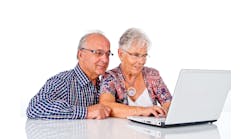It would be easy for a guy like Jorge Armando Brenes Salazar, M.D. to rest on his laurels and what he has accomplished so far.
Dr. Salazar is from Costa Rica, where unlike in the United States, medical school takes seven years to complete. After getting his degree from Escuela Autonoma de Ciencas Medicas de Centro America, he went north to Minneapolis. There, he did his four years of residency at Hennepin County Medical Center, in the Level 1 trauma center’s challenging training program.
For many, that would be enough learning. For Salazar, it was just the beginning. He currently is engaged in a program at the Mayo Clinic (Rochester, Minn.) for cardiovascular specialty training. After he completes that, he plans to dig even deeper and focus on geriatric cardiovascular training.
What’s more is Salazar is among a growing community of doctors that are using web-based tools to engage and learn from other physicians. Whether it’s Doximity (a network that claims 300,000 users), Sermo (claiming 270,000 users), or QuantiaMD (claiming 225,000 users), more than ever, doctors and other healthcare professionals are getting social with each other.
Salazar uses the Waltham, Mass.-based QuantiaMD as his network of choice. He was brought onto it by one of the residents he supervises. The tech-savvy resident was looking at presentations found on QuantiaMD during his breaks on his iPad. He showed it to Salazar, who was drawn to it immediately.
“One of the key advantages is that they have a select group of experts that are able to provide key counseling and key information on their field,” Salazar says. “You’re able to interact with them with questions and you even have the opportunity to address them in a private fashion with encrypted message. I have the luxury of being part of the Mayo Clinic. If I have a question, I can pick up the phone or run into someone down the hall. I have that luxury here. Others don’t have that.”
QuantiaMD, which works with providers from Mayo Clinc, National Institutes of Health, and other prominent healthcare provider organizations, allows doctors and practitioners to learn from others through 15-30 minute online presentations and interactive discussion.
There are also clinical case examples in the form of presentations and “image challenges,” where doctors have to interpret an image. The platform allows them to earn continuing medical education (CME) credits as well and focus on interests specific to them. For example, Salazar is alerted on his QuantiaMD home page when a new case on cardiovascular medicine pops up.
Salazar says the interface is “smooth,” and easy to use. “I can tell this is the case because many of the physicians are gray-haired professors and they use the website without any problems,” he says.
In terms of usefulness, Salazar says that he rarely comes across something that he doesn’t find useful. Most of the conditions covered in presentations aren’t extremely rare but uncommon enough that he says practitioners probably need better exposure to them. “There’s a lot of content in the community that you won’t find in structured textbooks and structured journals,” he says.
Some of this doesn’t even include clinical information. There are presentations on practical matters of being a doctor, such as learning to interact with difficult colleagues or finding ways to relax in a stressful atmosphere. “If you don’t take care of yourself as a healthcare professional you won’t be able to take care of others,” Salazar says.
In a time-crunched atmosphere, Salazar also finds it to be very practical. Not only is mobile-equipped, but the short presentations, lasting three-to-five minutes, are important enough to be eligible for recertification. Interacting with others through commenting, he adds, can be done just as quickly.
As more doctors turn to social media, Salazar says he hopes that QuantiaMD and other networks can recruit more international participants. He has worked with international participants before. He looks at the current crisis around the Ebola virus as an opportunity in this regard. Most notably, he mentored an intern in Pakistan on the topic of neurology.
“He told me he was a practitioner in Pakistan but he didn’t want to be in the back seat of medicine, he wanted to be the in driver’s seat. There’s a lot of potential everywhere. It’s just about networking,” Salazar says.


